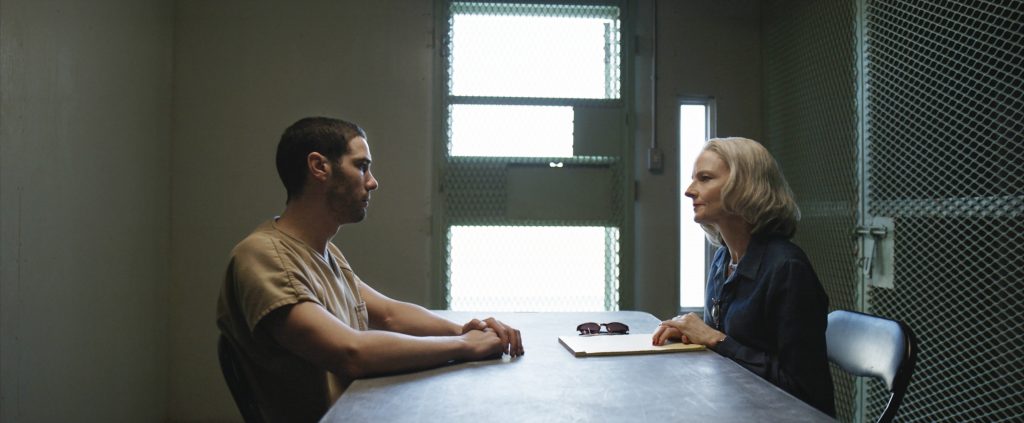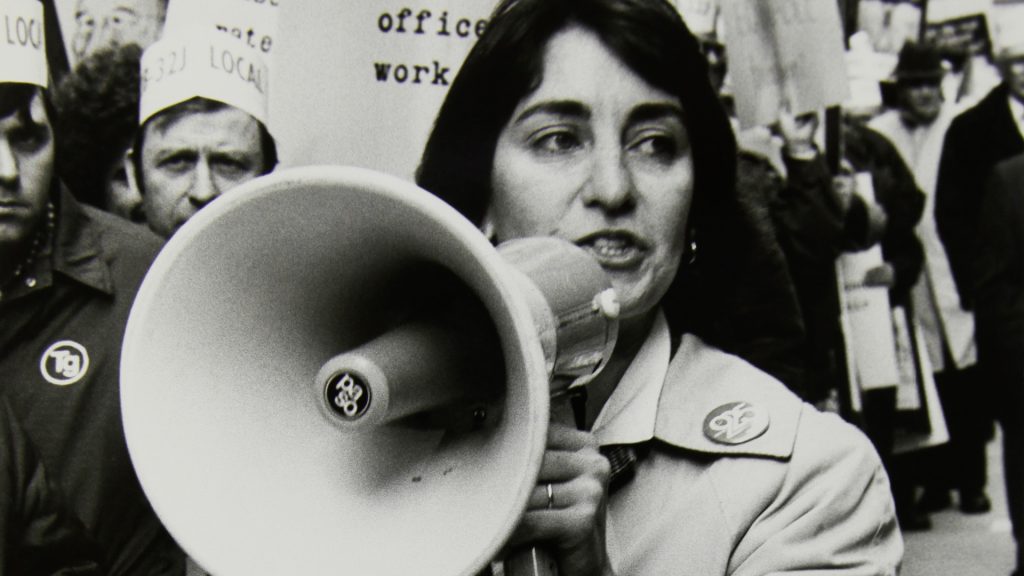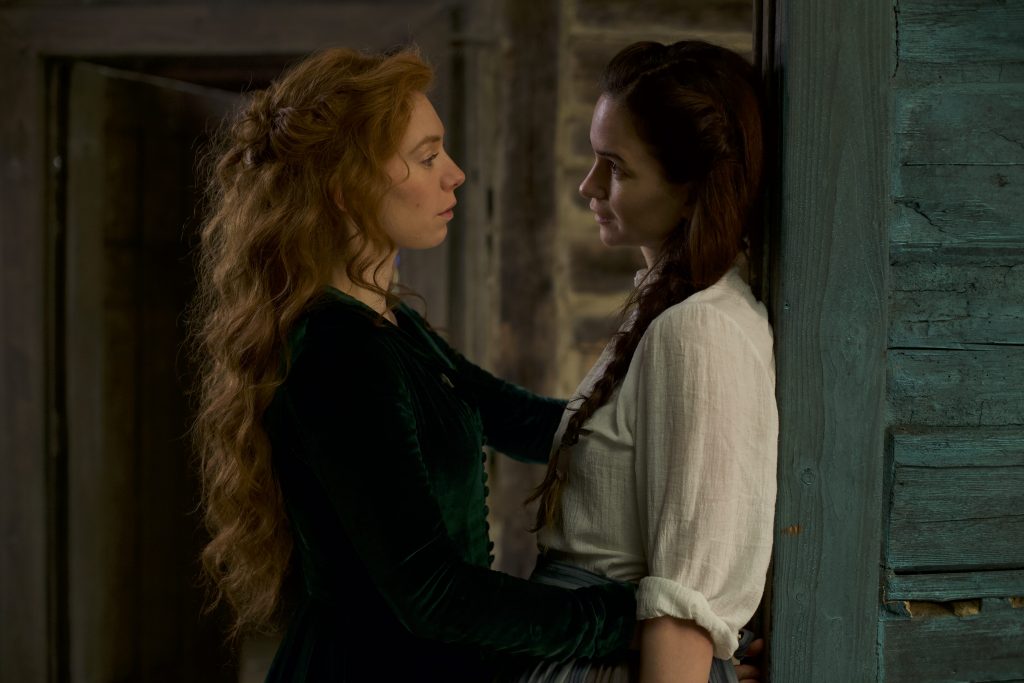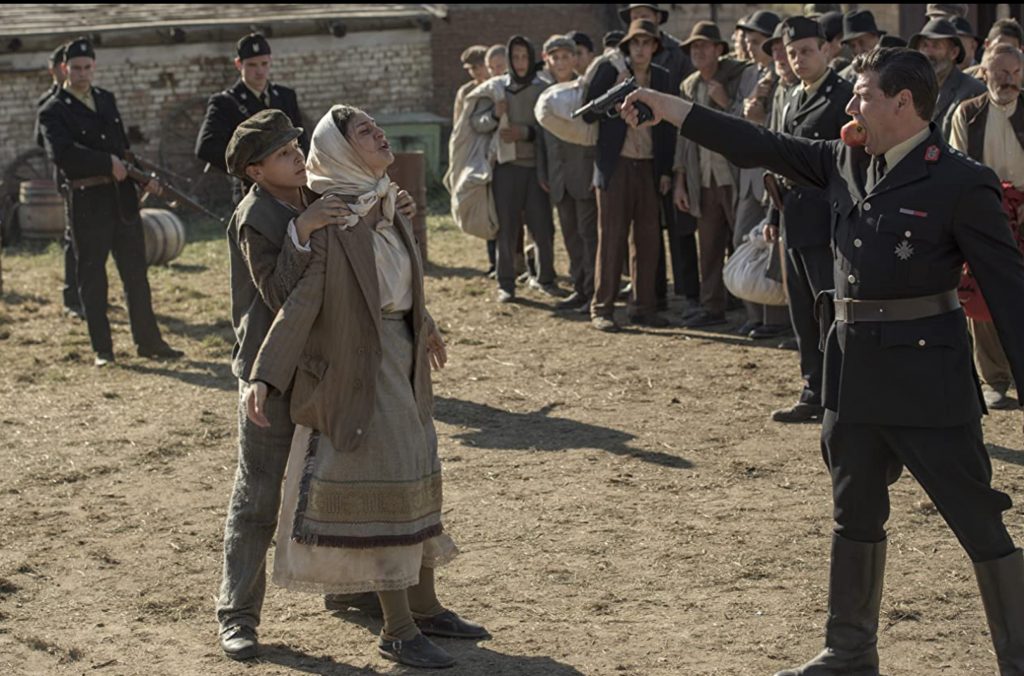February 19, 2021
by Carla Hay

Directed by Courtney Paige
Culture Representation: Taking place in an unnamed North American city, the horror flick “The Sinners” features a predominantly white cast of characters (with a few people of color) representing the middle-class and working-class.
Culture Clash: In a conservative Christian town, seven teenage girls form a cult-like clique where they each represent the seven deadly sins, and then members of the group start getting murdered.
Culture Audience: “The Sinners” will appeal primarily to people who are interested in independent horror films that are suspenseful and make the most out of their low budgets.
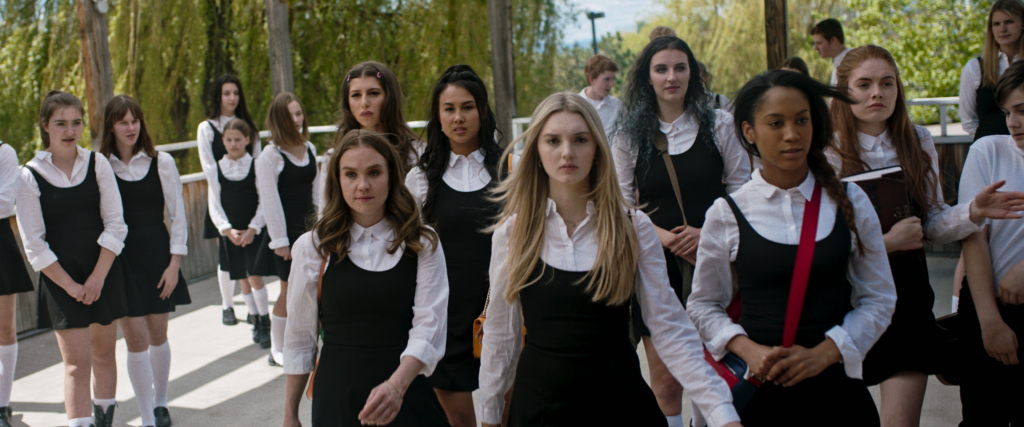
Before anyone dismisses “The Sinners” as just another horror movie where a bunch of teenagers get murdered, consider that it skillfully takes on religious bigotry and sexual oppression while balancing it with an intriguing mystery, gruesome horror and even some touches of comedy. It’s not an easy balancing act, but “The Sinners” mostly succeeds in being a memorable independent horror film in a sea of mindless slasher flicks.
“The Sinners” is the feature-film directorial debut of Courtney Paige, who wrote the screenplay with Erin Hazlehurst and Madison Smith. Paige is also an actress, which might explain why the casting is better than most low-budget movies of this type. Some of the acting is amateurish, but the dynamics between the actors look more authentic and natural than a lot of horror movies that could care less about character development or chemistry between the actors.
The story of “The Sinners” centers on a clique of seven girls who are classmates in their last year at a Christian high school in an unnamed city in North America. (The movie was actually filmed in Paige’s Canadian hometown of Kelowna, British Columbia.) These teenagers call themselves The Sins, and they have each assigned themselves to represent one of the seven deadly sins. They are:
- Grace Carver (played by Kaitlyn Bernard), the group’s assertive blonde leader, represents the sin of lust. It’s ironic because Grace, who is the child of a strict pastor, is a virgin, but she has a secret love that’s considered taboo in her religion.
- Tori Davidson (played by Brenna Coates), who sometimes dresses as an emo or Goth, represents the sin of wrath. She’s the tough-talking rebel of the group, and she’s in a secretive romance with Grace.
- Katie Hamilton (played by Keilani Elizabeth Rose), who is very spoiled and materialistic, represents the sin of greed. She likes to make others feel inferior by bragging about what her wealth can buy her.
- Molly McIvor (played by Carli Fawcett), a compulsive eater, represents the sin of gluttony. She is very self-conscious about her looks because she’s not as thin as the other girls in the group.
- Robyn Pearce (played by Natalie Malaika), a passive follower, represents the sin of sloth. She wants to go to a good college but is too lazy to study, so she cheats instead.
- Stacey Rodgers (played by Jasmine Randhawa), who often compares herself to other people, represents the sin of envy. Her loyalty depends on what she can get out of it.
- Aubrey Miller (played by Brenna Llewellyn), a quiet redhead who becomes a target for the others’ bullying, represents the sin of pride. The other members of the Sins turn on Aubrey when Grace decides that Aubrey is a snitch.
Aubrey is the narrator of the movie, which opens with a scene of Aubrey being kidnapped by the other Sins, who are wearing masks. This kidnapping ends up being the catalyst for much of the horror that happens in the last third of the film, when certain members of the Sins are murdered, one by one. This isn’t a slasher film where the murderer is revealed from the beginning. There are several people who could be suspects.
Out of all the members of the Sins, Grace is the one whose home life is shown the most. She lives with her parents and three siblings in a very oppressive and religious home ruled over by her father Pastor Dean Carver (played by Tahmoh Penikett), who demands that everything has to be done his way. Grace’s mother Brenda Carver (played by Loretta Walsh) is passive, but she has compassion and often acts as a peacemaker when Dean and Grace get into arguments.
Grace’s older sister Hannah (played by Karis Cameron) sometimes shares Grace’s tendency to be sarcastic and rebellious. By contrast, their younger teenage brother Luke Carver (played by Maxwell Haynes) wants to be the family’s “goody-two-shoes” child and is ready to tattle on Grace and Hannah to their father if he sees them doing anything wrong. The youngest child in the family is a baby boy, who’s briefly seen in the movie and whose name is not mentioned.
At the beginning of the movie, Grace has broken up with a fellow student named Kit Anderson (played by Dylan Playfair), who is still pining for Grace because he keeps calling her and trying to get back together with her. Some of the students, including the other members of the Sins, are aware that Grace and Tori are more than friends. However, Kit is in denial that Grace could be a member of the LGBTQ community and ignores the rumors that are swirling about Grace’s sexuality.
Grace and Tori have to keep their romance a secret, because they go to a religious high school (where all the students wear uniforms and have classes where they study the Bible) and they live in a very conservative Christian community. Tori and Grace canoodle in bathroom stalls at school, and their study sessions in Grace’s bedroom have some snuggling and kissing. Grace’s pastor father doesn’t really approve of Tori, who’s the type of student who will get sent to the principal’s office for blurting out impatiently in class: “Jesus, are you done?”
Grace’s father also doesn’t really approve of Grace’s part-time after-school job working at a flower stand called Andy’s Flower Stream. The business, which operates out of an Airstream trailer, is owned by a bohemian type named Andy Lund (played by James Neate), who’s a laid-back and friendly boss. Andy lives in the trailer with his hippie-ish girlfriend Summer Dobson (played by Jen Araki), who encourages Grace to walk in bare feet and feel “love and light.”
In a voiceover, Aubrey says about Summer, who used to be Aubrey’s babysitter: “I always had a creepy feeling about her. You know the people who always claim ‘light and love and positive.’ Well, they’re usually the most broken.” But the person Aubrey dislikes the most is Tori, because she thinks Tori is a hateful bully.
The top law enforcement official in town is Sherriff Fred Middleton (played by Aleks Paunovic), who provides some of the movie’s comic relief because he tries to be imposing but he’s really kind of a goofball. He’s first seen in the movie when he shows up in the empty classroom where his wife Maggie Middleton (played by Elysia Rotaru) is a teacher at the high school. (Maggie is also Andy’s sister.)
Maggie walks in the classroom and tells Fred, as she unbuttons her blouse, that they have nine minutes before the students arrive for the next class. Fred and Maggie, who’ve been trying to start a family, end up having quickie sex in the classroom. It’s played for laughs because Aubrey, who sees Fred leave the classroom and guesses what he had been doing there, asks him what he has on his collar. He quickly looks to see if a stain is there (there isn’t) and figures out that Aubrey was just trying to embarrass him when she tells him that she tried to go into the classroom but the door was locked.
Aubrey keeps a journal of her innermost thoughts. And all hell breaks loose when Tori and Kathy steal Aubrey’s journal. Certain incidents lead the other Sins to believe that Aubrey has been snitching on them. And when they find out what Aubrey has to say about them in the journal, their suspicions seem to be confirmed.
First, they lure Aubrey into a “study group” session which turns out to be an excuse to harass and haze her. Then, they kidnap Aubrey and take her to a remote wooded area, where things spiral out of control, but Aubrey manages to escape and goes missing. And then, other members of the Sins start to disappear and are brutally murdered.
Sheriff Middleton and his Deputy Douglas Sanders (played by Taylor St. Pierre) end up clashing with the higher-level government detectives who are sent to investigate the murders. The outside investigators are Detective Zankowski (played Michael Eklund) and Detective O’Ryan (played by Lochlyn Munro), who treat the sheriff and the deputy like incompetent yokels. Middleton and Sanders think that they’re being undermined by arrogant big-city types who don’t know the community. Meanwhile, as these two factions have their power struggle, more of the Sins get killed.
“The Sinners” makes great use of cinematography by Stirling Bancroft to create an atmosphere of foreboding beneath the pristine and orderly exterior of this suburban community. (There’s a recurring image of a rose stuck in the mouth of dead girl that’s particularly striking. It’s probably why the move was originally titled “The Color Rose.”) The movie’s production design and costume design are well-done, given the film’s small budget. And the whodunit aspect of the mystery is not as predictable as viewers might think it is.
There’s only one scene in the movie that seems awkward and out-of-place. It involves Grace having a secret occult meeting with two women and one man who look at least 10 years older than she is. It’s never explained how a sheltered preacher’s kid like Grace came to find these people or how long she’s known them. And the scene ends up being irrelevant, given what happens at the end of the movie.
The actresses who portray the seven Sins are convincing as a pack of “mean girls” who are “frenemies,” with their loyalty to each other always in question. As Tori, Coates stands out with having the most realistic acting and also the most obviously complicated character. On the one hand, Tori is exactly the type of bully that Aubrey despises. On the other hand, Tori has a very tough-but-tender side to her that’s loving with Grace and very protective of her. Their secret romance adds another layer of terror and anxiety in the story, since the unforgiving homophobia in their community makes Grace and Tori afraid to be open about the true nature of their relationship.
“The Sinners” is definitely not a horror classic on the level of director David Fincher’s 1995 film “Seven,” another macabre thriller with the seven deadly sins as its theme. As far as slasher films go, “The Sinners” can be considered slightly better than most. And it’s also a promising feature directorial debut for Paige, who shows she has a knack for telling a gripping horror story in a way that can capture people’s interest from beginning to end.
Brainstorm Media released “The Sinners” on digital and VOD on February 19, 2021.
UPDATE: Lifetime will premiere the movie under the title “The Virgin Sinners” on August 21, 2021.

